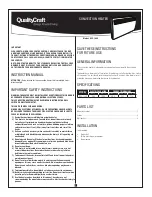
www.dimplex.de 452161.66.01 · FD 9307
EN-3
English
LIK 8TES
1.4 Energy-Efficient Use of the
Heat Pump
With the purchase of this heat pump you are helping to protect
the environment. A prerequisite for energy-efficient operation is
the correct design of the heat source system and heating system
(radiators and circulation pump).
It is particularly important for the efficiency of a heat pump to
keep the temperature difference between heating water and heat
source as small as possible. For this reason, it is advisable to de-
sign the heat source and heating system very carefully.
A tem-
perature difference of approx. one Kelvin (1 °C) increases
the power consumption by around 2.5 %.
When designing the
heating system, it should be borne in mind that special consum-
ers such as e.g. hot water preparation should also be considered
and dimensioned for low temperatures.
Underfloor heating
systems (panel heating)
are optimally suited for heat pump use
on account of the low flow temperatures (30 °C to 40 °C).
It is important to ensure that the heat exchangers are not con-
taminated during operation because this increases the tempera-
ture difference, in turn reducing the COP.
Correct adjustment of the heat pump manager is also important
for energy-efficient use of the heat pump. Further information can
be found in the heat pump manager's operating instructions.
The heat pump is equipped with an
overflow mechanism
to pre-
vent very low flow rates in the heat pump.
The installed buffer tank increases the amount of water in the
heating circuit and guarantees reliable defrosting.
2 Purpose of the Heat
Pump
2.1 Application
The air-to-water heat pump is to be used exclusively for the heat-
ing of heating water. It can be used in newly built or previously
existing heating systems.
The heat pump is suitable for mono energy and bivalent opera-
tion down to an external temperature of -20 °C.
Proper defrosting of the evaporator is guaranteed by maintaining
a heating water return flow temperature of more than 18 °C dur-
ing continuous operation.
The heat pump is not designed for the increased heat consump-
tion required when a building is being dried out. The additional
heat consumption should be met using special devices provided
by the customer. If a building is to be dried out in autumn or win-
ter, we recommend installing an additional heating element
(available as an accessory).
NOTE
The device is not suitable for operation with a frequency converter.
2.2 Operating Principle
Outside air is drawn in by the ventilator and fed via the evapora-
tor (heat exchanger). The evaporator cools the air, i.e. it extracts
heat from it. This extracted heat is then transferred to the working
medium (refrigerant) in the evaporator.
The heat is “pumped” to a higher temperature level by increasing
its pressure with the aid of an electrically driven compressor. It is
then transferred to the heating water using the liquifier (heat ex-
changer).
Electrical energy is used to raise the temperature of the heat in
the environment to a higher level. Because the energy extracted
from the air is transferred to the heating water, this type of device
is called an air-to-water heat pump.
The air-to-water heat pump consists of the main components
evaporator, ventilator and expansion valve, as well as the low-
noise compressor, liquifier and electrical control system.
At low ambient temperatures, humidity accumulates on the evap-
orator in the form of frost reducing the transfer of heat. Uneve ac-
cumulation during this process does not indicate a fault.The
evaporator is defrosted automatically by the heat pump as re-
quired. Steam may be emitted from the air outlet depending on
the atmospheric conditions.
















































